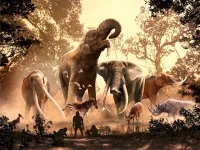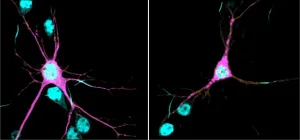How children integrate information
Researchers use a computer model to explain how children integrate information during word learning
2021-07-01
(Press-News.org) "We know that children use a lot of different information sources in their social environment, including their own knowledge, to learn new words. But the picture that emerges from the existing research is that children have a bag of tricks that they can use", says Manuel Bohn, a researcher at the Max Planck Institute for Evolutionary Anthropology.
For example, if you show a child an object they already know - say a cup - as well as an object they have never seen before, the child will usually think that a word they never heard before belongs with the new object. Why? Children use information in the form of their existing knowledge of words (the thing you drink out of is called a "cup") to infer that the object that doesn't have a name goes with the name that doesn't have an object. Other information comes from the social context: children remember past interactions with a speaker to find out what they are likely to talk about next.
"But in the real world, children learn words in complex social settings in which more than just one type of information is available. They have to use their knowledge of words while interacting with a speaker. Word learning always requires integrating multiple, different information sources", Bohn continues. An open question is how children combine different, sometimes even conflicting, sources of information.
Predictions by a computer program
In a new study, a team of researchers from the Max Planck Institute for Evolutionary Anthropology, MIT, and Stanford University takes on this issue. In a first step, they conducted a series of experiments to measure children's sensitivity to different information sources. Next, they formulated a computational cognitive model which details the way that this information is integrated.
"You can think of this model as a little computer program. We input children's sensitivity to different information, which we measure in separate experiments, and then the program simulates what should happen if those information sources are combined in a rational way. The model spits out predictions for what should happen in hypothetical new situations in which these information sources are all available", explains Michael Henry Tessler, one of the lead-authors of the study.
In a final step, the researchers turned these hypothetical situations into real experiments. They collected data with two- to five-year-old children to test how well the predictions from the model line up with real-world data. Bohn sums up the results: "It is remarkable how well the rational model of information integration predicted children's actual behavior in these new situations. It tells us we are on the right track in understanding from a mathematical perspective how children learn language."
Language learning as a social inference problem
How does the model work? The algorithm that processes the different information sources and integrates them is inspired by decades of research in philosophy, developmental psychology, and linguistics. At its heart, the model looks at language learning as a social inference problem, in which the child tries to find out what the speaker means - what their intention is. The different information sources are all systematically related to this underlying intention, which provides a natural way of integrating them.
Additionally, the model also specifies what changes as children get older. Over development, children become more sensitive to the individual information sources, and yet the social reasoning process that integrates the information sources remains the same.
"The virtue of computational modeling is that you can articulate a range of alternative hypotheses - alternative models - with different internal wiring to test if other theories would make equally good or better predictions. In some of these alternatives, we assumed that children ignore some of the information sources. In others, we assumed that the way in which children integrate the different information sources changes with age. None of these alternative models provided a better explanation of children's behavior than the rational integration model", explains Tessler.
The study offers several exciting and thought-provoking results that inform our understanding of how children learn language. Beyond that, it opens up a new, interdisciplinary way of doing research. "Our goal was to put formal models in a direct dialogue with experimental data. These two approaches have been largely separated in child development research", says Manuel Bohn. The next steps in this research program will be to test the robustness of this theoretical model. To do so, the team is currently working on experiments that involve a new set of information sources to be integrated.
INFORMATION:
[Attachments] See images for this press release:

ELSE PRESS RELEASES FROM THIS DATE:
2021-07-01
In a rapidly changing Arctic, one area might serve as a refuge - a place that could continue to harbor ice-dependent species when conditions in nearby areas become inhospitable. This region north of Greenland and the islands of the Canadian Arctic Archipelago has been termed the Last Ice Area. But research led by the University of Washington suggests that parts of this area are already showing a decline in summer sea ice.
Last August, sea ice north of Greenland showed its vulnerability to the long-term effects of climate change, according to a study published July 1 in the open-access journal Communications Earth & Environment.
"Current thinking is that this area may be the last refuge for ice-dependent ...
2021-07-01
Elephants and their forebears were pushed into wipeout by waves of extreme global environmental change, rather than overhunting by early humans, according to new research.
The study, published today in Nature Ecology & Evolution, challenges claims that early human hunters slaughtered prehistoric elephants, mammoths and mastodonts to extinction over millennia. Instead, its findings indicate the extinction of the last mammoths and mastodonts at the end of the last Ice Age marked the end of progressive climate-driven global decline among elephants over millions of years.
Although elephants today are restricted to just three endangered species in the African and Asian tropics, these are survivors of a once far more diverse and widespread group of giant herbivores, known ...
2021-07-01
FINDINGS
Men with high-risk prostate cancer with at least one additional aggressive feature have the best outcomes when treated with multiple healthcare disciplines, known as multimodality care, according to a UCLA study led by Dr. Amar Kishan, assistant professor of radiation oncology at the David Geffen School of Medicine at UCLA and a researcher at the UCLA Jonsson Comprehensive Cancer Center.
The study found no difference in prostate cancer-specific deaths across treatment modalities when patients received guideline-concordant multimodality therapy, which in this case was inclusion of hormone therapy for men receiving radiation ...
2021-07-01
A water disinfectant created on the spot using just hydrogen and the air around us is millions of times more effective at killing viruses and bacteria than traditional commercial methods, according to scientists from Cardiff University.
Reporting their findings today in the journal Nature Catalysis, the team say the results could revolutionise water disinfection technologies and present an unprecedented opportunity to provide clean water to communities that need it most.
Their new method works by using a catalyst made from gold and palladium that takes in hydrogen and oxygen to form ...
2021-07-01
As many expectant mothers know, getting enough folate is key to avoiding neural tube defects in the baby during pregnancy. But for the individuals who carry certain genetic variants, dealing with folate deficiency can be a life-long struggle which can lead to serious neurological and heart problems and even death.
Now a Donnelly Centre study offers clues to how to recognize early those who are most at risk.
Defects in an enzyme called MTHFR, or 5,10-methylenetetrahydrofolate reductase, which modifies folate, or vitamin B9 as it is also known, to produce ...
2021-07-01
CHAPEL HILL, NC - Scientists at the University of North Carolina at Chapel Hill School of Medicine and colleagues have demonstrated that variants in the SPTBN1 gene can alter neuronal architecture, dramatically affecting their function and leading to a rare, newly defined neurodevelopmental syndrome in children.
Damaris Lorenzo, PhD, assistant professor in the UNC Department of Cell Biology and member of the UNC Neuroscience Center at the UNC School of Medicine, led this research, which was published today in the journal Nature Genetics. Lorenzo, who is also a member of the UNC Intellectual and Developmental Disabilities Research Center (IDDRC) at the UNC School of Medicine, is the ...
2021-07-01
Hundreds of genetic drivers affect sexual and reproductive behaviour
Combined with social factors, these can affect longevity and health
An Oxford-led team, working with Cambridge and international scholars, has discovered hundreds of genetic markers driving two of life's most momentous milestones - the age at which people first have sex and become parents.
In a paper published today in Nature Human Behaviour, the team linked 371 specific areas of our DNA, called genetic variants (known locations on chromosomes), 11 of which were sex-specific, to the timing of first sex and birth. These variants interact with environmental factors, such as socioeconomic status and when you were born, and are predictors of longevity and later life disease.
The researchers ...
2021-07-01
People who have lost their sense of smell are being failed by healthcare professionals, new research has revealed.
A study by Newcastle University, University of East Anglia and charity Fifth Sense, shows poor levels of understanding and care from GPs and specialists about smell and taste loss in patients.
This is an issue that has particularly come to the forefront during the Covid-19 pandemic as many people who have contracted the virus report a loss of taste and smell as their main symptoms.
Around one in 10 people who experience smell loss as a result of Covid-19 report that their sense of smell has ...
2021-07-01
In a new publication from Opto-Electronic Advances; DOI 10.29026/oea.2021.210040, Researchers led by Professor Daewook Kim from The University of Arizona, Tucson, AZ, USA consider advances in optical engineering for future telescopes.
Astronomical advances are largely coupled with technological improvements - from the invention of the first optical telescope used by Galileo in 1609 and for the foreseeable future, astronomy and optical engineering will be forever linked. This paper summarizes several advances that will enable future telescopes to expand scientific understanding of the universe. Significant optical engineering advances at the University of Arizona are being made for design, fabrication, and construction of next ...
2021-07-01
BLOOMINGTON, Ind. -- Scientists at Indiana University have found that significant amounts of the two main components of cannabis, THC and CBD, enter the embryonic brain of mice in utero and impair the mice's ability as adults to respond to fluoxetine, a drug commonly used to treat anxiety and depression and known by the brand name Prozac.
The study suggests that when the developing brain is exposed to THC or CBD, normal interactions between endocannabinoid and serotonin signaling may be diminished as they become adults.
"Hemp-derived CBD is a legal substance in the U.S., and we are in a time of increasing state-level legalization of cannabis. ...
LAST 30 PRESS RELEASES:
[Press-News.org] How children integrate information
Researchers use a computer model to explain how children integrate information during word learning




